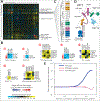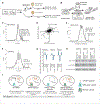A Quantitative Genetic Interaction Map of HIV Infection
- PMID: 32084337
- PMCID: PMC7462049
- DOI: 10.1016/j.molcel.2020.02.004
A Quantitative Genetic Interaction Map of HIV Infection
Abstract
We have developed a platform for quantitative genetic interaction mapping using viral infectivity as a functional readout and constructed a viral host-dependency epistasis map (vE-MAP) of 356 human genes linked to HIV function, comprising >63,000 pairwise genetic perturbations. The vE-MAP provides an expansive view of the genetic dependencies underlying HIV infection and can be used to identify drug targets and study viral mutations. We found that the RNA deadenylase complex, CNOT, is a central player in the vE-MAP and show that knockout of CNOT1, 10, and 11 suppressed HIV infection in primary T cells by upregulating innate immunity pathways. This phenotype was rescued by deletion of IRF7, a transcription factor regulating interferon-stimulated genes, revealing a previously unrecognized host signaling pathway involved in HIV infection. The vE-MAP represents a generic platform that can be used to study the global effects of how different pathogens hijack and rewire the host during infection.
Keywords: CCR4-NOT; CNOT complex; IRF7; combinatorial genetics; epistasis map; host-pathogen network biology; innate immunity; interferon stimulated gene; vE-MAP; viral infection genetic screen.
Copyright © 2020 Elsevier Inc. All rights reserved.
Conflict of interest statement
Declaration of Interests The Krogan Laboratory has received research support from Vir Biotechnology and F. Hoffmann-La Roche. A.M. is a co-founder of Spotlight Therapeutics and Arsenal Therapeutics. A.M. serves on the scientific advisory board of PACT Pharma, is an advisor to Sonoma Biotherapeutics, and was a former advisor to Juno Therapeutics. The Marson laboratory has received sponsored research support from Juno Therapeutics, Epinomics, Sanofi, and a gift from Gilead.
Figures





References
-
- Andrews S FastQC. Bioinformatics.babraham.ac.uk.
-
- Aronesty E (2011). EA-Utils: Command-line tools for processing biological sequencing data. Code.Google.com.
Publication types
MeSH terms
Substances
Grants and funding
LinkOut - more resources
Full Text Sources
Other Literature Sources
Medical
Molecular Biology Databases

